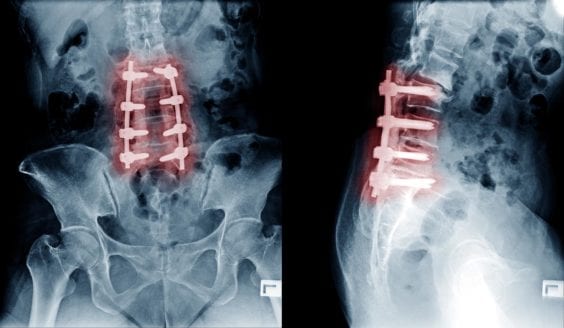Sciatica Causes: Sciatica is an indication of a more serious medical problem. 1 Understanding the causes of sciatica might help you focus your treatment on solving the problem rather than concealing the symptoms.
Sciatic nerve damage can occur as a consequence of direct nerve compression, inflammation, an aberrant immune system response, or a combination of all of these reasons.
Common Causes of Sciatica
Lumbar herniated disc is a common cause of sciatica. According to studies, a lumbar herniated disc is responsible for up to 90% of sciatica. 3 The sciatic nerve is formed by one or more spinal nerve roots (L4-S3) that are compressed by a herniated disc. Sciatica can be caused by a herniated lumbar disc in two ways:

- Direct compression. When a lumbar disc bulges (contained-disc-disorder) or when the soft inner material of the disc leaks out or herniates through the fibrous outer core (non-contained disc disorder), direct compression of the sciatic nerve occurs.
- Chemical inflammation. The disc material’s acidic chemical irritant (hyaluronan) may seep out, triggering inflammation and irritation surrounding the sciatic nerve.
A herniated disc can compress the sciatic nerve on one side, resulting in symptoms in one leg, or it can bulge or herniate on both sides, resulting in symptoms in both legs (bilateral sciatica). Bilateral sciatica can also be caused by two contiguous segmental discs on either side herniating, albeit this is an uncommon occurrence.
Degeneration. The sciatic nerve can be compressed or irritated by degeneration of tissues in the lumbar spine. The synovial tissue in the joint’s capsule can also become inflamed and bulky when the facet joints degenerate. Vertebral bone degeneration can result in aberrant bone growths (bone spurs or osteophytes). One or more nerve roots of the sciatic nerve may be compressed by these unusually thick tissues in the lumbar spine. Inflammatory proteins may be secreted by degenerated intervertebral discs, producing sciatic nerve irritation.
Read More:

Lumbar spinal stenosis. The narrowing of the spinal canal, known as spinal stenosis, is very frequent in persons over the age of 60. According to research, lateral recess stenosis is a prevalent cause of sciatica in the elderly.
Spondylolisthesis. A minor stress fracture causes one vertebral body to move forward on another, resulting in spondylolisthesis. The L5 vertebra, for example, may move forward over the S1 vertebra. Nerve compression can occur as a result of disc space collapse, fracture, or forward slippage of the vertebral body. Spondylolisthesis is more frequent in younger persons and can induce bilateral sciatica.
These diseases might emerge gradually or suddenly as a result of trauma or a physical stress injury. Direct damage to the sciatic nerve can occur as a result of car accidents, sports injuries, or falls. Physical stress injuries, such as those caused by weightlifting, can lead to spondylolisthesis and ruptured discs.

Causes of Sciatica-Like Symptoms
Some conditions may cause typical sciatica symptoms. A few examples include:
- Piriformis syndrome. Piriformis syndrome is caused by piriformis muscular contractions. When a spasmodic muscle irritates or compresses the sciatic nerve at its origin, sciatica symptoms can result. This problem is more likely when the sciatic nerve is divided, which is a normal variance near the piriformis muscle, or when the piriformis muscles themselves have typical anatomical variants. 10 Overuse injuries, particularly in runners and sportsmen, are typical causes of piriformis syndrome.
Sacroiliac joint dysfunction. Irritation of the sacroiliac joint (at the bottom of the spine) can irritate the L5 nerve (on top of the sacroiliac joint), resulting in sciatica-like pain.
There is no real radiculopathy or radiating nerve pain in these circumstances. However, the ensuing leg pain is often mistaken for sciatica.

Less Common Causes of Sciatica
Sciatica can be caused by tumours, infection, scar tissue development, fluid accumulation, Pott’s disease (spinal tuberculosis), or a lumbar spine fracture. Sciatica can also occur as a result of improper muscle injection procedures in the buttocks or after hip joint replacement surgery, albeit this is uncommon. Sciatica affects about 1% of pregnant women at some time throughout their pregnancy.

Risk Factors for Sciatica
The existence of certain risk factors may enhance the chances of sciatica developing. Here are a few examples:
- • Tobacco use • Depression and other mental illnesses
- • Obesity and excess weight in older age groups (50–60 years)
- • Genetic predisposition
- • Vitamin B 12 deficiency
- • Physical deconditioning from a sedentary, indolent lifestyle
- • Certain occupations (such as truck drivers, carpenters, or machine operators)
- • Poor work ergonomics
The attendance of these risk factors alone does not establish the cause for sciatica development. However, these factors combined with an individual’s age and general health may play a role in causing sciatica to develop.
The presence of certain risk factors does not prove that sciatica is the result of them. However, these factors, in combination with an individual’s age and overall health, may have a role in the development of sciatica.
Book Your Consultation
Website: www. klmgroup.org
Link: https://tinyurl.com/yyzvwmck
Email: info@klmgrou p.org
Ph: 0751-4000721,Mob: 7804826825 Address: 12, Saraswati Nagar, University Road, Near Silver Estate, Thatipur,

